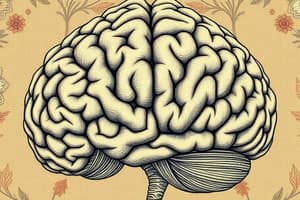Podcast
Questions and Answers
What is the primary function of the cerebellum?
What is the primary function of the cerebellum?
- Taste sensation coordination
- Language learning
- Balance regulation (correct)
- Visual perception processing
Where is the cerebellum located in the brain?
Where is the cerebellum located in the brain?
- Below the brainstem
- Near the frontal lobes
- Behind the temporal and occipital lobes (correct)
- Above the parietal lobes
During which stage of embryonic development does the cerebellum start developing neurons?
During which stage of embryonic development does the cerebellum start developing neurons?
- Day 18
- Day 30
- Day 10
- Day 26 (correct)
Which lobe of the cerebellum is associated with distinct neural connections?
Which lobe of the cerebellum is associated with distinct neural connections?
What percentage of the brain's neurons does the cerebellum contain?
What percentage of the brain's neurons does the cerebellum contain?
Which of the following is NOT a function of the cerebellum?
Which of the following is NOT a function of the cerebellum?
What is the primary role of the cerebellum in motor control?
What is the primary role of the cerebellum in motor control?
Which of the following is NOT a common cerebellar disorder?
Which of the following is NOT a common cerebellar disorder?
What is the function of the vermis in the cerebellum?
What is the function of the vermis in the cerebellum?
Which type of neuron is NOT found in the cerebellum?
Which type of neuron is NOT found in the cerebellum?
How does the cerebellum facilitate adaptation to new environments?
How does the cerebellum facilitate adaptation to new environments?
Which anatomical structure in the cerebellum corresponds to different functional domains?
Which anatomical structure in the cerebellum corresponds to different functional domains?
Flashcards are hidden until you start studying
Study Notes
Cerebellum: Understanding Its Functions, Development, Role in Motor Control, Disorders, and Anatomy
The cerebellum, located near the base of the brain behind the temporal and occipital lobes, plays a crucial role in motor control, balance regulation, and coordination. It represents about 10% of the brain's mass but contains nearly half of its neurons. The cerebellum is further divided into three main lobes: anterior, posterior, and flocculonodular, each with distinct functions and neural connections.
Functions
The cerebellum is primarily involved in motor functions, maintaining equilibrium, and fine motor skills. It coordinates movements, ensures smooth execution of movements, and aids in the acquisition of new skills through motor learning. Additionally, recent studies indicate that the cerebellum contributes to non-motor functions like visual perception and language processing.
Development
The development of the cerebellum occurs during embryonic stages, starting with the formation of the prosencephalon and mesencephalon in the early embryo. Later, the rhombencphalon develops, where the cerebellum, brainstem, and spinal cord originate. By day 26 of gestational age, the cerebellum starts developing neurons, and by day 28, the first Purkinje cells appear. The cerebellum continues growing until birth and completes its development several years after birth.
Role in Motor Control
The cerebellum plays a crucial role in motor control by regulating muscles' strength and flexibility. It monitors the body's movements continuously, assessing the quality of the output produced by the cerebral cortex and other areas. If necessary, the cerebellum makes small corrections to improve movement accuracy and fluidity. The cerebellum also facilitates adaptation to new environments, helping individuals adjust to unfamiliar situations to perform motor tasks more efficiently.
Disorders
Damage to the cerebellum can result in severe disorders, affecting motor coordination, balance, and trunk stability. Some common cerebellar disorders include cerebellar degenerative diseases, spinocerebellar atrophy, and Ataxia telangiectasia. Early diagnosis and proper treatment can significantly reduce the impact of these conditions on patients' lives.
Anatomy
Anatomically, the cerebellum is positioned beneath the tentorium cerebelli and above the brainstem. It comprises two hemispheres connected by the vermis, which contains the midline structures. The cerebellum's surface is organized into various zones, such as the zone of glomeruli, eminentia pyramidalis, and the uvula, which correspond to different functional domains. The cerebellum contains two types of neurons, granule cells, and Purkinje cells, interacting via parallel and feedback loops. These complex neural circuits enable the cerebellum to perform its diverse functions effectively.
Studying That Suits You
Use AI to generate personalized quizzes and flashcards to suit your learning preferences.




